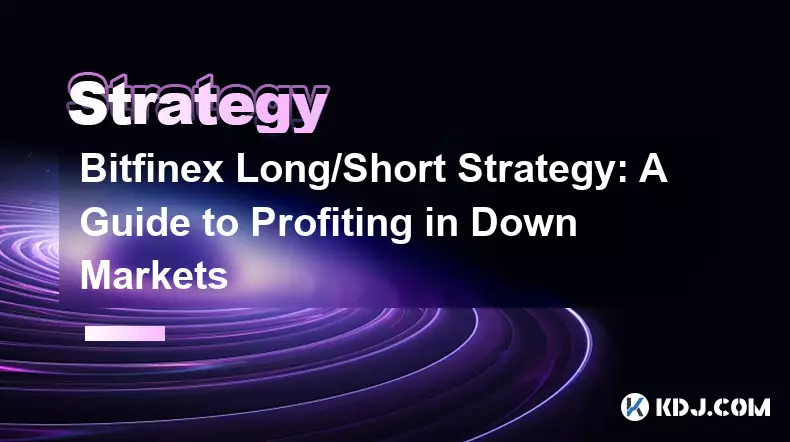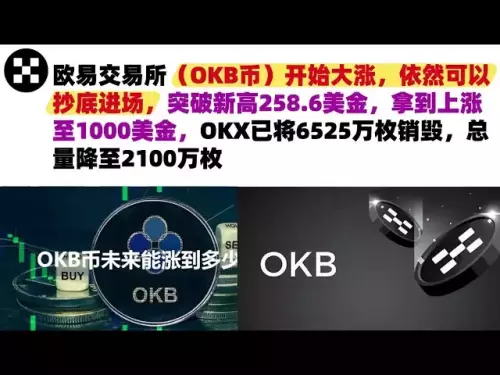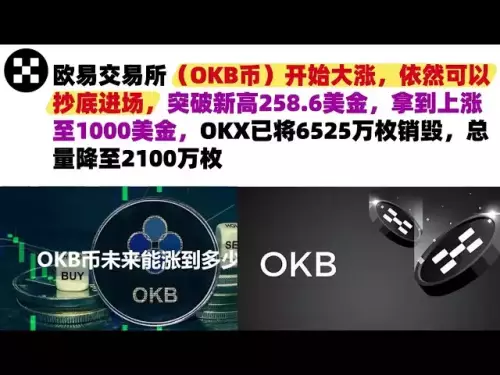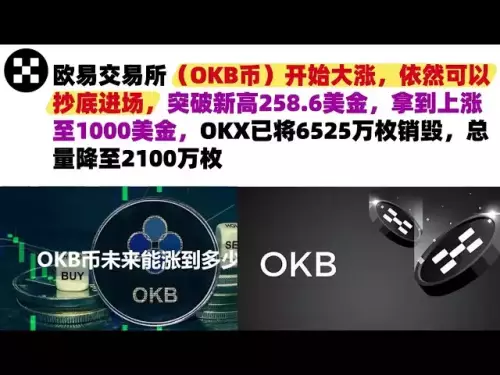-
 Bitcoin
Bitcoin $108600
-1.98% -
 Ethereum
Ethereum $4363
-1.06% -
 Tether USDt
Tether USDt $1.000
0.00% -
 XRP
XRP $2.792
-3.30% -
 BNB
BNB $854.8
-0.96% -
 Solana
Solana $200.6
-5.21% -
 USDC
USDC $0.9998
0.00% -
 Dogecoin
Dogecoin $0.2145
-2.01% -
 TRON
TRON $0.3387
-0.31% -
 Cardano
Cardano $0.8129
-3.32% -
 Chainlink
Chainlink $23.15
-2.64% -
 Hyperliquid
Hyperliquid $43.46
-3.79% -
 Ethena USDe
Ethena USDe $1.000
0.00% -
 Sui
Sui $3.289
-2.32% -
 Stellar
Stellar $0.3542
-2.67% -
 Bitcoin Cash
Bitcoin Cash $533.9
-0.92% -
 Cronos
Cronos $0.3090
1.58% -
 Avalanche
Avalanche $23.59
-2.33% -
 Hedera
Hedera $0.2236
-3.17% -
 UNUS SED LEO
UNUS SED LEO $9.507
0.87% -
 Litecoin
Litecoin $109.9
-0.98% -
 Toncoin
Toncoin $3.076
-0.21% -
 Shiba Inu
Shiba Inu $0.00001232
0.09% -
 Uniswap
Uniswap $9.700
-0.28% -
 Polkadot
Polkadot $3.766
-2.42% -
 Dai
Dai $0.0000
-0.01% -
 Bitget Token
Bitget Token $4.529
-1.25% -
 Monero
Monero $263.0
0.48% -
 Aave
Aave $316.0
0.95% -
 Ethena
Ethena $0.6607
-0.48%
How to use Bollinger Bands for Dogecoin trading?
Bollinger Bands help Dogecoin traders spot volatility shifts, breakouts, and overbought/oversold levels, especially when combined with volume and other indicators.
Aug 30, 2025 at 01:37 am

Understanding Bollinger Bands in Dogecoin Trading
1. Bollinger Bands consist of three lines plotted on a price chart: the middle band, which is a simple moving average (SMA), and two outer bands that represent standard deviations from the SMA. These bands dynamically adjust to market volatility, expanding during high volatility and contracting during low volatility. For Dogecoin traders, this makes Bollinger Bands a powerful tool for identifying potential price breakouts or reversals.
2. When the bands widen, it signals increased price volatility in the Dogecoin market. This often occurs before or during significant price movements, such as sharp rallies or sudden corrections. Traders can use this expansion as a cue to prepare for momentum trades, especially when combined with volume indicators to confirm the strength of the move.
3. Conversely, when the bands contract tightly around the price, it indicates a period of low volatility, often preceding a breakout. In the Dogecoin market, such 'squeeze' patterns can be highly predictive. A breakout above the upper band may suggest a bullish momentum surge, while a breakdown below the lower band could signal bearish pressure.
4. The middle SMA line acts as a dynamic support or resistance level. If Dogecoin’s price is trending above the middle band, it reflects bullish sentiment. A sustained move below this line may indicate weakening momentum and a potential trend reversal. This baseline helps traders assess the strength of the prevailing trend.
5. Bollinger Bands should not be used in isolation. Combining them with other technical tools like RSI or MACD enhances their effectiveness. For instance, if Dogecoin touches the upper band while the RSI shows overbought conditions, it increases the probability of a pullback. This confluence of signals improves trade accuracy.
Identifying Overbought and Oversold Conditions
1. When Dogecoin’s price touches or exceeds the upper Bollinger Band, it is often interpreted as overbought. This does not necessarily mean an immediate reversal, but it suggests that momentum may be stretched. Traders watch for bearish candlestick patterns or divergence in momentum indicators to confirm a potential shorting opportunity.
2. Similarly, when the price reaches the lower band, it may indicate oversold conditions. In a ranging Dogecoin market, this can present buying opportunities, especially if the price bounces off the lower band with strong volume. However, in a strong downtrend, touching the lower band might not signal a reversal but rather continued selling pressure.
3. It is critical to assess the broader market context before acting on overbought or oversold signals. For example, during a bullish crypto cycle, Dogecoin may remain overbought for extended periods as FOMO (fear of missing out) drives prices higher. Blindly shorting based on band touches can lead to losses.
4. The concept of 'band riding' is common in trending markets. In a strong uptrend, Dogecoin’s price may consistently hug the upper band, indicating sustained buying interest. In such cases, traders might look for entries on pullbacks toward the middle band rather than fading the trend at the upper boundary.
5. False signals can occur, especially during news-driven spikes. A sudden tweet or announcement related to Dogecoin can cause the price to spike through the upper band without any follow-through. This emphasizes the need for confirmation from volume, order book depth, or on-chain data.
Using Bollinger Bands for Breakout Strategies
1. The Bollinger Band 'squeeze' is a key setup for breakout traders. When the bands narrow significantly, it reflects low volatility and coiling price action. A decisive move beyond either band, accompanied by rising volume, can signal the start of a new trend in Dogecoin’s price.
2. Traders often place pending orders just above the upper band and below the lower band during a squeeze. Once the price breaches one of the bands, the order is triggered, allowing entry in the direction of the breakout. This strategy works best when confirmed by a spike in trading volume on major exchanges like Binance or Bybit.
3. False breakouts are common in low-liquidity altcoins, but Dogecoin’s high market cap and trading volume reduce this risk. Still, traders should use stop-loss orders to manage downside if the breakout fails and the price quickly re-enters the band range.
4. After a breakout, the former band can act as support or resistance. For example, if Dogecoin breaks above the upper band and continues upward, a retest of that level could provide a second entry point. This behavior reinforces the psychological significance of the bands.
5. Combining the squeeze with chart patterns like triangles or flags increases the reliability of breakout signals. If Dogecoin consolidates within a symmetrical triangle while the Bollinger Bands contract, a breakout in either direction becomes more probable and tradable.
Frequently Asked Questions
What time frame is best for using Bollinger Bands on Dogecoin?The 4-hour and daily charts are widely used for swing trading Dogecoin with Bollinger Bands. Shorter time frames like 15-minute charts can generate frequent signals but are more prone to noise and false moves.
Can Bollinger Bands predict exact price targets for Dogecoin?No, Bollinger Bands do not provide specific price targets. They highlight volatility and potential reversal or breakout zones. Traders must use additional tools like Fibonacci extensions or pivot points to estimate targets.
How do I adjust Bollinger Band settings for Dogecoin?The default setting is a 20-period SMA with 2 standard deviations. Some traders adjust the period to 50 for smoother bands in long-term analysis or reduce deviations to 1.5 for more sensitive signals in ranging markets.
Do Bollinger Bands work during low-volume periods for Dogecoin?Their effectiveness diminishes during low-volume periods, such as weekends or holidays, when price movements are less decisive. It is advisable to wait for volume confirmation before acting on band-based signals during such times.
Disclaimer:info@kdj.com
The information provided is not trading advice. kdj.com does not assume any responsibility for any investments made based on the information provided in this article. Cryptocurrencies are highly volatile and it is highly recommended that you invest with caution after thorough research!
If you believe that the content used on this website infringes your copyright, please contact us immediately (info@kdj.com) and we will delete it promptly.
- AAVE Price Prediction: Will It Breakout to $400 by September 2025?
- 2025-08-30 19:25:13
- Bitcoin, Ethereum, XRP Price Check: What's the Deal?
- 2025-08-30 19:05:16
- AI Coins in 2025: Riding the $LYNO Wave in the Cryptocurrency World
- 2025-08-30 19:45:13
- BlockchainFX, MAGACOIN FINANCE, Crypto Presale: The 2025 Hot List
- 2025-08-30 19:50:12
- Navigating the Crypto Treasury Landscape: Investor Knowledge and Trend Analysis
- 2025-08-30 20:05:17
- Trump, Rumors, and X (Twitter): A New York Minute on Crypto Chaos
- 2025-08-30 20:10:12
Related knowledge

Mastering Bitfinex: Advanced Strategies for Experienced Traders.
Aug 30,2025 at 01:54am
Optimizing Order Types for Maximum Efficiency1. Utilizing limit orders allows traders to set precise entry and exit points, ensuring control over trad...

Bitfinex Long/Short Strategy: A Guide to Profiting in Down Markets
Aug 30,2025 at 09:55am
Understanding the Bitfinex Long/Short Ratio1. The Bitfinex long/short ratio reflects the proportion of long positions to short positions held by trade...

What is a good RSI level to buy Dogecoin?
Aug 28,2025 at 02:29pm
Understanding RSI in Cryptocurrency Trading1. The Relative Strength Index (RSI) is a momentum oscillator widely used in technical analysis to measure ...

How to use Bollinger Bands for Dogecoin trading?
Aug 30,2025 at 01:37am
Understanding Bollinger Bands in Dogecoin Trading1. Bollinger Bands consist of three lines plotted on a price chart: the middle band, which is a simpl...

How to use stop-loss orders to limit potential losses?
Aug 08,2025 at 02:01pm
Understanding Stop-Loss Orders in Cryptocurrency TradingA stop-loss order is a risk management tool used by traders to automatically sell a cryptocurr...

What are the most promising altcoins to invest in?
Aug 10,2025 at 11:42am
Understanding the Role of Private Keys in Cryptocurrency WalletsIn the world of cryptocurrency, private keys are the cornerstone of ownership and cont...

Mastering Bitfinex: Advanced Strategies for Experienced Traders.
Aug 30,2025 at 01:54am
Optimizing Order Types for Maximum Efficiency1. Utilizing limit orders allows traders to set precise entry and exit points, ensuring control over trad...

Bitfinex Long/Short Strategy: A Guide to Profiting in Down Markets
Aug 30,2025 at 09:55am
Understanding the Bitfinex Long/Short Ratio1. The Bitfinex long/short ratio reflects the proportion of long positions to short positions held by trade...

What is a good RSI level to buy Dogecoin?
Aug 28,2025 at 02:29pm
Understanding RSI in Cryptocurrency Trading1. The Relative Strength Index (RSI) is a momentum oscillator widely used in technical analysis to measure ...

How to use Bollinger Bands for Dogecoin trading?
Aug 30,2025 at 01:37am
Understanding Bollinger Bands in Dogecoin Trading1. Bollinger Bands consist of three lines plotted on a price chart: the middle band, which is a simpl...

How to use stop-loss orders to limit potential losses?
Aug 08,2025 at 02:01pm
Understanding Stop-Loss Orders in Cryptocurrency TradingA stop-loss order is a risk management tool used by traders to automatically sell a cryptocurr...

What are the most promising altcoins to invest in?
Aug 10,2025 at 11:42am
Understanding the Role of Private Keys in Cryptocurrency WalletsIn the world of cryptocurrency, private keys are the cornerstone of ownership and cont...
See all articles

























































































